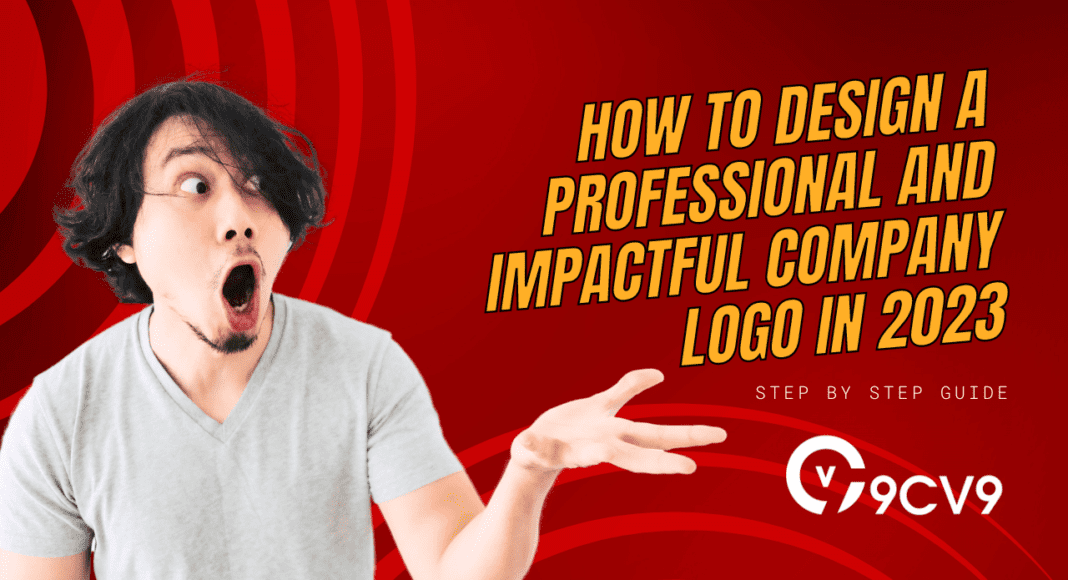Key Takeaways
- Understand your brand’s purpose and target audience to design a logo that effectively communicates your brand’s message.
- Incorporate key elements such as simplicity, versatility, and originality to create a visually appealing and memorable logo.
- Test and refine your logo to ensure its visual appeal, brand alignment, scalability, and legibility, and implement it consistently across all platforms to strengthen brand recognition.
In today’s competitive business landscape, where brands are vying for consumers’ attention, the significance of a well-designed company logo cannot be overstated.
A logo serves as the face of a brand, encapsulating its essence, values, and identity in a visual representation.
It acts as a powerful tool that can communicate a brand’s story, evoke emotions, and leave a lasting impression on the audience.
However, designing a professional and impactful company logo is no simple task.
It requires a thoughtful and strategic approach, blending creativity, aesthetics, and brand positioning.
To embark on this journey of logo creation, one must understand the underlying principles, elements, and techniques that contribute to a successful design.
This comprehensive guide is your gateway to unlocking the secrets of crafting a logo that not only captures the essence of your brand but also resonates with your target audience.
We will delve into the step-by-step process, explore the key elements that make a logo effective, and provide invaluable insights and tips from industry experts.
Get ready to unleash your creativity and create a logo that will elevate your brand to new heights.
Section by section, we will navigate the intricacies of logo design, beginning with understanding the purpose and target audience.
By defining your company’s values, and mission, and identifying your target market, you can lay a solid foundation for the logo creation process.
We will also delve into researching competitors’ logos to find inspiration and ensure differentiation.
Moving forward, we will explore the key elements that constitute an effective logo design.
Simplicity and scalability, color psychology and symbolism, typography and font selection, as well as iconography and visual representation, will be dissected to help you comprehend their significance in logo creation.
Armed with this knowledge, you will be equipped to make informed decisions that align with your brand’s personality and resonate with your audience.
In the heart of this guide, we will present a step-by-step process for designing your company logo.
Starting from preliminary sketches and brainstorming ideas, we will guide you through the process of refining concepts and selecting the best design direction.
You will learn how to translate your ideas into a digital format using design software, experiment with color schemes and variations, and incorporate feedback and iterations to refine and improve your logo.
Throughout the journey, we will provide essential tips for creating an impactful logo.
From making it unique and memorable to ensuring versatility across different platforms and mediums, we will unveil the strategies employed by renowned designers to captivate audiences and leave a lasting impression.
Moreover, we will emphasize the importance of steering clear of clichés and outdated design trends while aiming for timeless appeal that withstands the test of time.
But the journey doesn’t end with the creation of a logo; it extends to testing, refining, and implementing it effectively.
We will shed light on the significance of seeking feedback from trusted sources and target audience, conducting A/B testing to evaluate the logo’s effectiveness, and making necessary adjustments to finalize the design.
Additionally, we will provide guidance on choosing the right file formats, ensuring consistency across marketing materials, and establishing clear guidelines for proper logo usage and placement.
By the end of this guide, you will emerge with a deep understanding of the intricate process of designing a professional and impactful company logo.
Armed with knowledge, inspiration, and practical insights, you will be well-equipped to embark on your logo creation journey and elevate your brand’s visual identity to new heights of success.
Get ready to embark on an exciting adventure that will unravel the art of designing a professional and impactful company logo. Let’s dive in.
How to Design a Professional and Impactful Company Logo In 2023
- Understanding the Purpose and Target Audience
- Key Elements of an Effective Logo Design
- Step-by-Step Process for Designing a Company Logo
- Tips for Creating an Impactful Logo
- Testing and Refining the Logo
- Implementing the Logo
1. Understanding the Purpose and Target Audience
When it comes to designing a company logo, a crucial first step is gaining a deep understanding of the purpose behind the logo and the target audience it aims to captivate.
The purpose sets the tone for the design, while the target audience dictates the style, aesthetics, and messaging that resonate with them.
Let’s explore this foundational aspect of logo design in detail.
Defining the Purpose
Every company logo has a purpose beyond being a mere visual representation.
It serves as a strategic tool to communicate the brand’s values, identity, and mission.
By defining the purpose of your logo, you can align it with your overall brand strategy and ensure consistency across all touchpoints.
For example, if you’re a tech startup focusing on innovative solutions, your logo may aim to convey cutting-edge technology, creativity, and forward-thinking. In this case, the purpose of your logo is to establish your brand as a leader in the industry, exuding innovation and reliability.

On the other hand, if you’re a sustainable fashion brand, your logo might emphasize eco-friendliness, ethics, and style.
Here, the purpose is to communicate your commitment to sustainability and attract conscious consumers who value ethical fashion choices.

Understanding the Target Audience:
To design a logo that resonates with your audience, you must have a clear understanding of who they are.
By identifying their demographics, psychographics, preferences, and behaviors, you can create a logo that captures their attention and establishes a strong connection.
For instance, let’s consider a fitness brand targeting millennials who are health-conscious and tech-savvy. The logo for this brand may incorporate vibrant colors, sleek typography, and modern imagery to appeal to their visually-driven and active lifestyle.

Contrastingly, a luxury skincare brand targeting affluent women over 40 may opt for a more elegant and sophisticated logo design.

It may feature refined typography, subtle color palettes, and a minimalist approach to exude a sense of prestige and exclusivity.
By conducting thorough market research, analyzing customer feedback, and studying competitors’ logos, you can gain valuable insights into the preferences and expectations of your target audience.
This knowledge becomes the driving force behind your logo design decisions.
Examples of Purpose and Target Audience Alignment:
- Nike: The iconic Nike logo, known as the “Swoosh,” perfectly aligns with its purpose and target audience. The purpose of the logo is to represent speed, movement, and athleticism. It captures the essence of Nike’s brand philosophy, “Just Do It.” The target audience, primarily athletes and sports enthusiasts, resonates with the logo’s dynamic and energetic design.
- Starbucks: The Starbucks logo is an excellent example of purpose and target audience alignment. The purpose of the logo is to convey the brand’s commitment to quality coffee and create a warm and inviting atmosphere. The target audience, coffee lovers seeking a cozy and relaxed ambiance, can connect with the logo’s iconic green siren, evoking a sense of comfort and familiarity.
- FedEx: The FedEx logo showcases how purpose can be cleverly embedded in a logo design. The purpose of the logo is to emphasize speed, reliability, and efficient delivery services. The target audience, individuals and businesses in need of reliable shipping solutions, appreciates the hidden arrow symbol within the logo, subtly conveying movement and progress.

When purpose and target audience alignment are successfully achieved, a logo becomes a powerful tool that communicates a brand’s values and resonates with its intended audience.
By understanding the purpose and target audience of your logo, you lay a solid foundation for designing a logo that accurately represents your brand and captivates the right people.
2. Key Elements of an Effective Logo Design
Designing a successful logo goes beyond aesthetics; it requires a keen understanding of the key elements that contribute to its effectiveness.
These elements encompass various aspects, including simplicity, scalability, color psychology, typography, and iconography.
Let’s delve into each of these elements and explore how they shape a visually impactful logo design.
- Simplicity: Simplicity is a fundamental principle in logo design. A simple logo is memorable, versatile, and easily recognizable. It allows for quick comprehension and leaves a lasting impression on viewers. Think of some of the most iconic logos, such as Apple, Nike, or McDonald’s. Their simplicity enables instant recognition and effortless recall.
For example, the Apple logo consists of a single bitten apple silhouette, devoid of any intricate details or excessive elements.
This simplicity not only conveys the brand’s focus on clean and minimalist design but also ensures its scalability across various sizes and mediums.

- Scalability: A logo’s scalability refers to its ability to maintain visual clarity and legibility when scaled up or down. It should be equally effective whether displayed on a small website icon or a large billboard. Scalability is vital to ensure that the logo retains its impact and message across different applications and sizes.
Consider the iconic Nike “Swoosh” logo. It remains recognizable even when scaled down to the size of a shoe tag or enlarged on the side of a building.
The clean lines and lack of intricate details make it highly scalable, allowing for seamless integration across a wide range of contexts.
- Color Psychology: Colors play a crucial role in logo design, evoking emotions, influencing perception, and communicating brand personality. Each color has its own psychological associations, and understanding their impact is essential when selecting the color palette for a logo.
For instance, blue is often associated with trust, reliability, and professionalism, making it a popular choice for corporate logos.
Facebook’s logo incorporates blue to convey a sense of trustworthiness and security.

In contrast, vibrant colors like red or orange can evoke energy, excitement, and passion, as seen in the logo of YouTube.

- Typography: Typography in logo design is about selecting the right fonts or customizing letterforms to create a distinctive visual identity. Fonts can communicate different tones and characteristics, such as elegance, playfulness, or authority, depending on the brand’s personality and target audience.
The Coca-Cola logo showcases the power of typography.
The unique and recognizable script font creates a sense of nostalgia, timeless elegance, and brand heritage.
This distinct typography has become synonymous with the Coca-Cola brand.

- Iconography and Visual Representation: Icons and visual representations within a logo can be powerful elements that convey the essence of a brand or its industry. These visual elements can range from abstract shapes and symbols to literal depictions of objects or characters.
Consider the logo of Twitter, which features a simple and recognizable bird icon.

The bird symbolizes freedom, communication, and the idea of “tweeting.”
The iconography effectively captures the brand’s core essence and resonates with its platform’s purpose.
By understanding and mastering these key elements of logo design, you can create visually impactful logos that leave a lasting impression on your target audience.
Simplicity and scalability ensure ease of recognition and application, while color psychology allows you to evoke specific emotions and associations.
Typography and iconography play a crucial role in defining the visual identity of your brand.
In the next section, we will delve into the step-by-step process of designing a company logo, equipping you with practical knowledge to bring your logo ideas to life.
Get ready to embark on an exciting journey of creativity and craftsmanship.
3. Step-by-Step Process for Designing a Company Logo
Designing a company logo is an art that requires a systematic approach and a blend of creativity, strategy, and technical skills.
In this section, we will walk you through a step-by-step process that will empower you to bring your logo ideas to life, ensuring a seamless journey from initial inspiration to a visually captivating masterpiece.
Let’s dive in.
- Define Your Design Brief: Before diving into the creative process, it’s crucial to have a clear understanding of the project requirements. Begin by gathering essential information about your brand, target audience, industry, values, and desired brand personality. This will serve as the foundation for your logo design.
Key considerations:
- Brand name and positioning
- Target audience demographics and psychographics
- Industry and competitors
- Desired brand personality and message
- Conduct Preliminary Research: Research serves as a source of inspiration and helps you understand current design trends, competitor logos, and successful logo designs in your industry. Analyze the logos of your competitors to identify opportunities for differentiation and gather ideas that resonate with your target audience.
- Sketch and Brainstorm Ideas: The sketching and brainstorming phase allows you to explore a wide range of ideas and concepts. Grab a pen and paper and let your creativity flow. Experiment with different shapes, symbols, and typography. Don’t worry about perfection at this stage; it’s all about generating a diverse pool of ideas. If you are looking for a top logo designer, then we highly recommend using 9cv9 Design Job Portal to hire the best graphic designers in the world.
- Refine and Select Concepts: Review your sketches and select the most promising concepts to develop further. Focus on clarity, simplicity, and alignment with your brand’s values and target audience. Consider how each concept aligns with the purpose of your logo and evokes the desired emotions and associations.
- Digitalize the Chosen Concept: Once you’ve chosen a concept to pursue, it’s time to digitize your design. Use vector-based design software like Adobe Illustrator to create a clean and scalable version of your logo. Pay attention to precise lines, shapes, and proportions, ensuring that your logo retains its visual appeal when resized.
- Experiment with Colors and Typography: Colors and typography play a significant role in logo design, so it’s time to experiment with different combinations. Consider the psychology of colors and select hues that align with your brand’s personality and evoke the desired emotions. Explore various fonts and typography styles that complement your logo concept.
- Obtain Feedback and Iterate: Gather feedback from trusted sources, such as colleagues, friends, or focus groups. Consider their perspectives and suggestions while staying true to your brand’s vision. Iterate on your design based on constructive feedback, refining and enhancing the elements that need improvement.
- Test Your Logo: Before finalizing your logo, it’s essential to test its effectiveness. Display it across various mediums, such as digital screens, print materials, and merchandise, to ensure its legibility, scalability, and visual impact. Test how it appears in different sizes, backgrounds, and color variations.
- Make Final Adjustments: Based on the testing phase, make any necessary final adjustments to your logo. Fine-tune details, refine color choices, and ensure consistency in typography and spacing. Pay close attention to small details as they can make a significant difference in the overall visual appeal.
- Save and Export in Multiple Formats: Save your logo in various file formats, including vector formats like .AI or .EPS, as well as high-resolution raster formats like .PNG or .JPEG. These formats will allow for flexibility in using your logo across different platforms, applications, and sizes without compromising its quality.
Congratulations!
You’ve successfully navigated the step-by-step process of designing a company logo.
Your dedication, creativity, and attention to detail have resulted in a visually captivating masterpiece that reflects your brand’s essence and resonates with your target audience.
4. Tips for Creating an Impactful Logo
Creating an impactful logo requires a combination of creativity, strategic thinking, and attention to detail.
In this section, we will share valuable tips and best practices to help you craft a logo that leaves a lasting impression on your target audience.
Let’s explore these tips and learn from relevant examples along the way.
- Keep it Simple: Simplicity is the key to a memorable and timeless logo. Avoid overcrowding your design with excessive elements or intricate details. Aim for clean lines, minimalism, and clarity. Remember, some of the most iconic logos in the world, such as the Apple logo or the Nike “Swoosh,” are remarkably simple yet instantly recognizable.
- Make it Versatile: Ensure your logo remains visually appealing and legible across different mediums and sizes. A versatile logo can be easily scaled up or down without losing its impact or compromising its readability. Test your logo in various formats, from small icons to large banners, to ensure its adaptability.
- Focus on Originality: Strive for originality in your logo design to stand out from the competition. While it’s essential to be aware of industry trends and best practices, avoid replicating existing logos. Instead, aim to create a unique visual identity that captures the essence of your brand. Consider the FedEx logo, which incorporates a hidden arrow within its typography, providing a clever and memorable touch of originality.
- Consider Target Audience Perception: Understanding your target audience’s preferences and expectations is crucial for designing a logo that resonates with them. Consider their demographics, psychographics, and cultural nuances when making design decisions. For example, a logo targeting a young, tech-savvy audience may embrace bold colors and modern typography, while a logo for a luxury brand may opt for elegance and sophistication.
- Reflect Your Brand’s Personality: Your logo should be a visual representation of your brand’s personality and values. Consider the emotions and associations you want your logo to evoke. A playful and vibrant logo may be suitable for a children’s clothing brand, while a sleek and professional logo would align with a corporate finance company. Aligning your logo with your brand’s personality will help establish a strong connection with your target audience.
- Choose Colors Wisely: Colors have a profound impact on human psychology and can evoke specific emotions and associations. Choose colors that align with your brand’s personality and resonate with your target audience. For example, green often symbolizes growth, nature, and health, making it a popular choice for organic and eco-friendly brands like Whole Foods Market.
- Typography Matters: Typography plays a significant role in logo design, contributing to the overall visual appeal and message of your logo. Select fonts that complement your brand’s personality and enhance readability. Experiment with different typography styles, from clean and modern to elegant and handwritten, to find the perfect fit for your logo. The typography in the Coca-Cola logo, with its timeless script font, reflects the brand’s classic and nostalgic image.
- Test for Scalability and Legibility: Before finalizing your logo, ensure it remains clear, legible, and visually appealing when scaled down or enlarged. Test it across different sizes and mediums, including digital platforms, print materials, and merchandise. A logo that loses its impact or becomes illegible when resized can diminish its effectiveness.
- Seek Feedback: Gather feedback from trusted sources, such as colleagues, clients, or focus groups. Their perspectives can provide valuable insights and help identify areas for improvement. Constructive feedback allows you to refine your design, ensuring your logo aligns with your brand’s vision and resonates with your target audience.
- Strive for Timelessness: Aim to create a logo that withstands the test of time. While it’s essential to stay current with design trends, avoid following fleeting fads that may quickly become outdated. Opt for a design approach that balances modernity with timeless appeal. The logo of the fashion brand Chanel is a testament to timelessness, maintaining its elegance and sophistication since its inception.
By following these tips and best practices, you can elevate your logo design skills and create an impactful logo that embodies your brand’s essence and captivates your target audience.
Remember, logo design is a dynamic process that requires continuous learning, adaptation, and refinement.
5. Testing and Refining the Logo
Testing and refining your logo is a critical step in the logo design process.
It allows you to evaluate its effectiveness, ensure visual consistency, and make necessary adjustments to enhance its impact.
In this section, we will explore various testing methods and share relevant examples to guide you in testing and refining your logo to perfection.
Let’s dive in!
- Assessing Visual Appeal: The first aspect to consider when testing your logo is its visual appeal. Gather feedback from a diverse group of individuals representing your target audience and stakeholders. Consider their initial impressions, emotional responses, and overall perception of the logo’s aesthetics. Does it capture attention? Does it communicate the intended message? Feedback from this stage will help you identify any design elements that may need refinement.
- Evaluating Brand Alignment: A logo should align with your brand’s values, personality, and overall brand identity. Test the logo’s compatibility with your brand by evaluating its consistency with other brand assets such as your website, marketing materials, and social media profiles. Ensure that the logo enhances brand recognition and reinforces brand association. For instance, the logo of Google incorporates playful colors and a clean design, aligning with the brand’s youthful and innovative image.
- Testing Scalability: A logo should retain its visual clarity and impact when scaled to different sizes. Test the logo across various applications, from digital screens to print materials, and assess its legibility and recognizability. Ensure that intricate details, if present, are not lost when the logo is scaled down. The Nike “Swoosh” logo is a prime example of scalability, as it remains distinguishable even when displayed in small sizes, such as on shoe tags.
- Checking Legibility: Legibility is crucial, especially when it comes to typographic elements in your logo. Test the logo’s legibility by reviewing it in different contexts and backgrounds. Consider its readability in both small and large sizes, as well as its clarity when displayed on various color backgrounds. Ensure that the text is clear and easily understandable, even at a glance. The logo of FedEx is an excellent example of legibility, as the hidden arrow within its typography is cleverly integrated without compromising readability.
- Conducting A/B Testing: A/B testing involves comparing different versions of your logo to determine which one resonates better with your target audience. Create multiple variations of your logo, each with slight variations in color, typography, or layout, and present them to a sample group. Gather feedback on which version is preferred, as well as the reasons behind their preference. This data-driven approach can help you make informed decisions during the refinement process.
- Seeking Professional Opinion: Consider consulting with professional designers or branding experts for an unbiased evaluation of your logo. They can provide valuable insights, identify areas for improvement, and offer recommendations based on their expertise. Their objective perspective can help you refine your logo to ensure it aligns with industry standards and best practices.
- Iterating and Refining: Based on the feedback and insights gathered during the testing phase, iteratively refine your logo design. Make necessary adjustments to enhance its visual impact, legibility, and alignment with your brand. Fine-tune elements such as color palette, typography, spacing, and overall composition. Strive for a balance between preserving the core identity of the logo and incorporating refinements that elevate its effectiveness.
- Documenting Brand Guidelines: Once you have refined your logo, create comprehensive brand guidelines to ensure consistency in its application. These guidelines should include specifications for logo usage, color variations, typography, minimum size requirements, clear space around the logo, and any other specific guidelines that maintain visual integrity. The brand guidelines act as a reference for anyone using the logo, ensuring that its representation remains consistent across all touchpoints.
Remember, testing and refining your logo is an iterative process.
Embrace feedback, be open to making adjustments, and continuously seek opportunities to improve.
By following this comprehensive testing and refinement approach, you can ensure that your logo becomes a flawless visual representation of your brand.
To kickstart hiring a top-quality Logo Designer, post 1 free job posting at 9cv9 Job Portal.
6. Implementing the Logo
Once you have designed and refined your logo, it’s time to implement it effectively across various channels and touchpoints.
Implementing your logo requires careful consideration of its placement, consistency, and integration within your brand’s overall identity.
In this section, we will explore best practices and relevant examples to guide you in successfully implementing your logo.
Let’s dive in!
- Establish Brand Guidelines: Before implementing your logo, it’s crucial to create brand guidelines that outline its proper usage. These guidelines should provide clear instructions on logo placement, sizing, color variations, background usage, minimum clear space, and any other specifications that maintain visual consistency. Consistent implementation of your logo will reinforce brand recognition and establish a strong brand identity.
- Logo Placement: Consider the most effective and visible placement for your logo across different platforms and mediums. Typically, logos are positioned at the top left or center of a website, on the upper corner of marketing collateral, or on the front of physical products. However, the placement may vary depending on the specific context. Test different placements to ensure optimal visibility and alignment with your overall design layout.
- Consistency is Key: Consistency is vital in logo implementation to create a cohesive and recognizable brand identity. Ensure that your logo is consistently applied across all touchpoints, including your website, social media profiles, packaging, promotional materials, and offline presence. Consistency in logo size, colors, and typography will enhance brand recognition and build trust with your audience.
- Digital Applications: In the digital realm, it’s essential to optimize your logo for various platforms and devices. Ensure that your logo is responsive and adapts seamlessly to different screen sizes, resolutions, and orientations. Test its visibility and legibility on mobile devices, tablets, and desktop screens. Additionally, consider creating a favicon—a small icon displayed in a browser’s address bar—to enhance brand visibility and reinforce brand identity.
- Print and Physical Applications: When implementing your logo in print and physical materials, such as business cards, brochures, signage, or packaging, ensure that the logo maintains its visual appeal and legibility across different print sizes and materials. Pay attention to color accuracy by using CMYK or Pantone color codes for precise reproduction. Test the logo’s readability and visual impact on various print materials to ensure consistency and quality.
- Social Media Integration: Integrate your logo seamlessly across your social media profiles to establish a strong brand presence. Optimize your profile pictures and cover photos to feature your logo prominently. Ensure that the logo is scaled appropriately for each platform, taking into account display dimensions and image size restrictions. Consistency in logo usage across social media platforms will strengthen brand recognition and create a cohesive online presence.
- Brand Collateral: Extend the implementation of your logo to brand collateral such as letterheads, email signatures, presentations, and invoices. Consistently incorporating your logo in these materials not only enhances brand recognition but also reinforces professionalism and attention to detail. Create templates and guidelines for your team to ensure consistent logo usage across all brand collateral.
- Physical Environments and Signage: If you have a physical location, leverage your logo to create a visually compelling environment that reflects your brand identity. Incorporate your logo into signage, window displays, office interiors, and vehicle branding. Use appropriate materials, sizes, and colors to ensure visibility and brand consistency. The iconic golden arches of the McDonald’s logo, for example, are instantly recognizable and integrated into their physical environments worldwide.
- Brand Partnerships and Collaborations: When entering into brand partnerships or collaborations, ensure that your logo is represented accurately and consistently. Provide guidelines to partners on logo usage and maintain control over its implementation to protect your brand identity. Collaborative efforts should reinforce your brand message and maintain a cohesive visual identity across all associated materials.
- Monitor and Adapt: After implementing your logo, closely monitor its usage across different channels and touchpoints. Regularly assess its effectiveness, visual consistency, and alignment with your brand’s evolving identity. Be prepared to make necessary adjustments or refinements as your brand grows and adapts to changing market dynamics.
By implementing your logo effectively and consistently across various platforms and touchpoints, you can unleash the full power of your brand identity and strengthen brand recognition.
Let your logo be the visual anchor that connects your audience to your brand’s values and promises.
Conclusion
Designing a professional and impactful company logo is a complex but rewarding endeavor.
A well-designed logo has the power to communicate your brand’s identity, capture the attention of your target audience, and leave a lasting impression in their minds.
Throughout this comprehensive guide, we have explored the essential steps, tips, and best practices to help you create a logo that embodies your brand’s essence and resonates with your audience.
Let’s recap the key takeaways:
- Understand the Purpose and Target Audience: Gain a deep understanding of your brand’s purpose, values, and target audience to create a logo that effectively communicates your brand’s message.
- Key Elements of an Effective Logo Design: Incorporate key elements such as simplicity, versatility, originality, and brand alignment to create a logo that is visually appealing, timeless, and memorable.
- Step-by-Step Process for Designing a Company Logo: Follow a systematic process that includes research, conceptualization, sketching, digitization, and refinement to ensure a well-crafted logo that aligns with your brand’s vision.
- Tips for Creating an Impactful Logo: Embrace tips such as keeping it simple, reflecting your brand’s personality, choosing colors wisely, and seeking feedback to create a logo that stands out and resonates with your target audience.
- Testing and Refining the Logo: Test your logo for visual appeal, brand alignment, scalability, legibility, and conduct A/B testing to refine and enhance its effectiveness.
- Implementing the Logo: Implement your logo consistently across various platforms, ensuring proper placement, scalability, and integration within your brand’s identity.
Throughout this journey, we have explored relevant examples of successful logos to inspire and guide your design decisions.
From the simplicity of the Apple logo to the hidden arrow in the FedEx logo, these examples illustrate the power of well-designed logos in creating brand recognition and resonance.
Remember, the logo is just one piece of the larger brand identity puzzle.
It should seamlessly integrate with your brand’s values, messaging, and overall visual identity across all touchpoints.
Consistency and attention to detail are paramount in creating a cohesive and powerful brand presence.
As you embark on the logo design process, continuously seek inspiration, stay abreast of design trends, and be open to feedback and refinement.
The world of logo design is ever-evolving, and your logo should have the flexibility to adapt while remaining true to your brand’s core essence.
By following the steps and best practices outlined in this guide, you are equipped with the knowledge and tools to design a professional and impactful company logo that represents your brand with distinction.
So, go forth and unleash your creativity to craft a logo that resonates, captivates, and stands the test of time.
Remember, your logo is the visual ambassador of your brand, and it has the potential to make a lasting impression on your audience.
Take pride in your logo and let it be a symbol of your brand’s excellence, innovation, and unwavering commitment to delivering value to your customers.
Good luck on your logo design journey, and may your logo become a beacon that attracts and inspires your target audience for years to come.
If your startup and company needs HR, hiring, or corporate services, you can use 9cv9 hiring and recruitment services. Book a consultation slot here, or send over an email to [email protected].
If you find this article useful, why not share it with your hiring manager and C-level suite friends and also leave a nice comment below?
We, at the 9cv9 Research Team, strive to bring the latest and most meaningful data, guides, and statistics to your doorstep.
To get access to top-quality guides, click over to 9cv9 Blog.
People Also Ask
How can I design my company logo?
To design your company logo, start by understanding your brand’s identity and target audience. Sketch out ideas, choose a color scheme, and create a balanced and scalable design. Consider simplicity, versatility, and uniqueness. Refine your concept, seek feedback, and finalize your logo using design software or by hiring a professional designer.
Is design a brand or logo?
Design encompasses both brand and logo. Brand design involves creating a cohesive visual identity that represents a company’s values and personality. Logo design focuses specifically on creating a unique symbol or mark that visually represents the brand, serving as a recognizable and memorable identifier.
What is a business logo designer?
A business logo designer is a professional who specializes in creating unique and visually appealing logos for companies. They possess expertise in graphic design, branding, and understanding a company’s identity to create a logo that effectively communicates the brand’s message and resonates with the target audience.































![Writing A Good CV [6 Tips To Improve Your CV] 6 Tips To Improve Your CV](https://blog.9cv9.com/wp-content/uploads/2020/06/2020-06-02-2-100x70.png)


